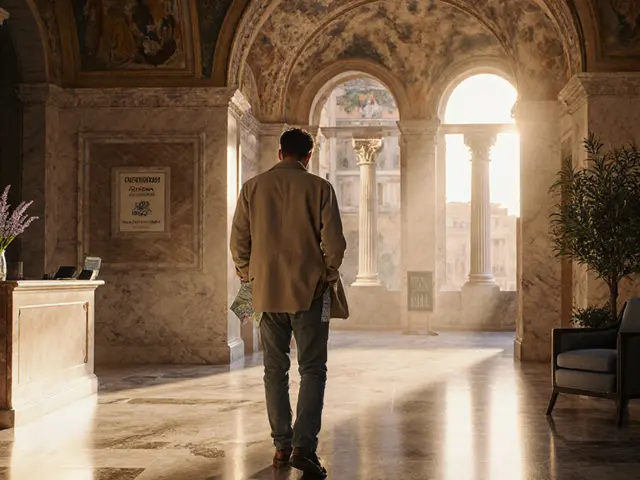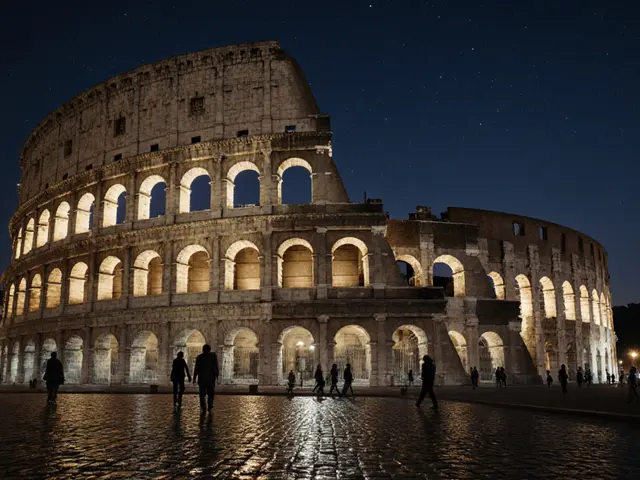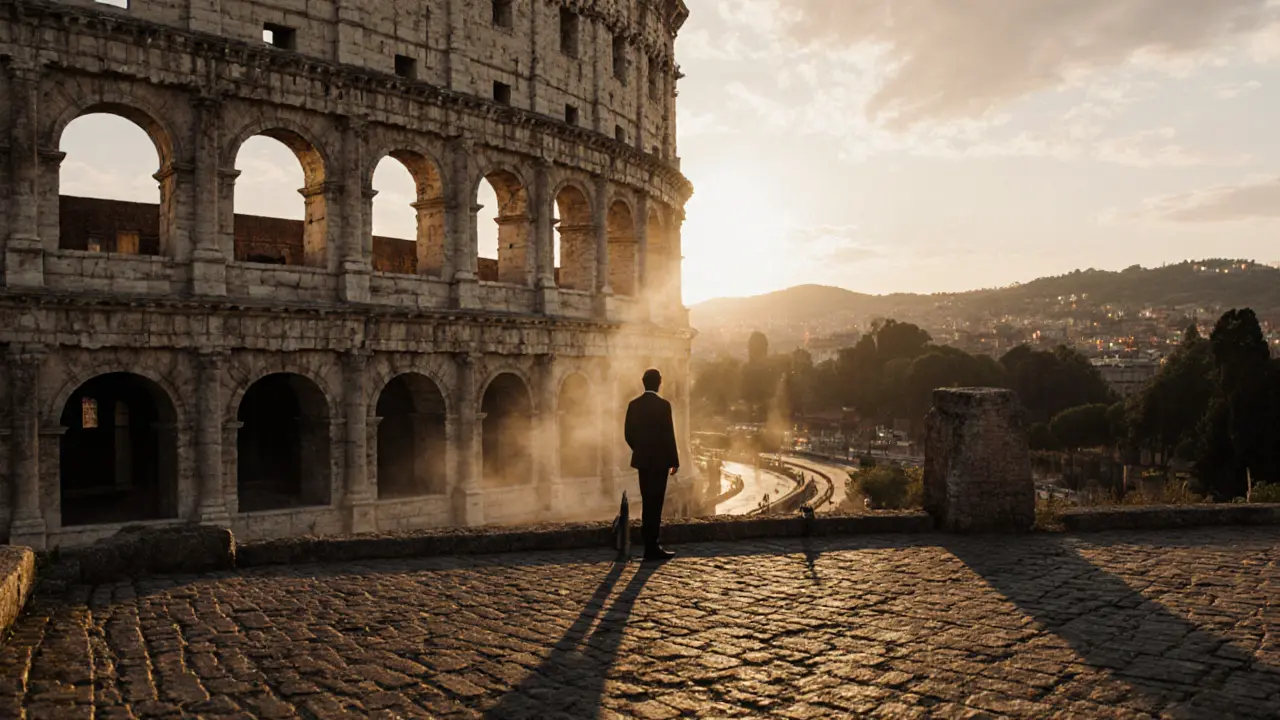
Walk through Rome and you’re not just walking down a street-you’re stepping on centuries. The cobblestones beneath your feet have heard emperors parade, monks chant, and revolutionaries shout. Today, those same stones lead you to gladiator arenas, Renaissance fountains, and hidden trattorias where nonnas still roll pasta by hand. This isn’t a museum tour. It’s a living, breathing adventure where history doesn’t stay behind glass-it greets you at every corner.
Stand in the Shadow of the Colosseum
The Colosseum isn’t just an old amphitheater. It’s the largest ancient amphitheater ever built, capable of holding 50,000 spectators who once roared for gladiators, wild beasts, and mock naval battles. Go early, before the tour groups swarm, and walk around the outer ring. Notice how the arches were stacked with different stone types-travertine, tuff, and brick-each chosen for strength and speed of construction. Inside, you can descend into the hypogeum, the maze of tunnels where animals and fighters waited before their moment in the sun. The air down there is cool, damp, and thick with the ghosts of screams and cheers. You’ll feel it.
Get Lost in the Roman Forum
Just a five-minute walk from the Colosseum, the Roman Forum was the beating heart of ancient Rome. This wasn’t just a marketplace-it was where senators debated laws, merchants sold spices from the East, and public speeches shaped the fate of an empire. Today, you’ll find broken columns, cracked marble floors, and the foundations of temples to gods like Saturn and Vesta. Don’t just glance at the ruins. Crouch down near the Temple of Antoninus and Faustina and trace the carved acanthus leaves still visible on the stone. That’s 2,000-year-old craftsmanship, untouched by modern tools. The Forum doesn’t shout its history-it whispers it. You have to lean in to hear.
Climb the Spanish Steps at Sunset
By late afternoon, the Spanish Steps start to fill with locals and tourists alike, but not for the same reason. Locals sit on the steps to chat, snack on gelato, and watch the world pass by. Tourists take photos, but few realize the steps were built in 1723 to connect the Trinità dei Monti church with the Piazza di Spagna below. Climb to the top as the sun dips behind the Pincio Hill. The golden light hits the Baroque facade of the church, and for a few minutes, Rome glows like a painting. If you’re lucky, you’ll catch a street musician playing a violin piece by Vivaldi-something he’s probably played here every evening for the last 20 years.
Explore the Pantheon’s Perfect Dome
The Pantheon is the oldest building in the world still in use, and it still blows minds. Its dome, 43.3 meters wide, was the largest unreinforced concrete dome ever built-over 1,900 years ago. At the top, a 9-meter-wide oculus opens to the sky. Rain falls through it, but the floor is slanted and drains it away. No gutters, no pipes-just smart Roman engineering. Stand in the center and look up. The light shifts as the sun moves, painting the interior in different tones. At noon, a perfect circle of sunlight hits the doorway. Go at 11 a.m. or 2 p.m. to see it. No sign tells you this. You have to know.
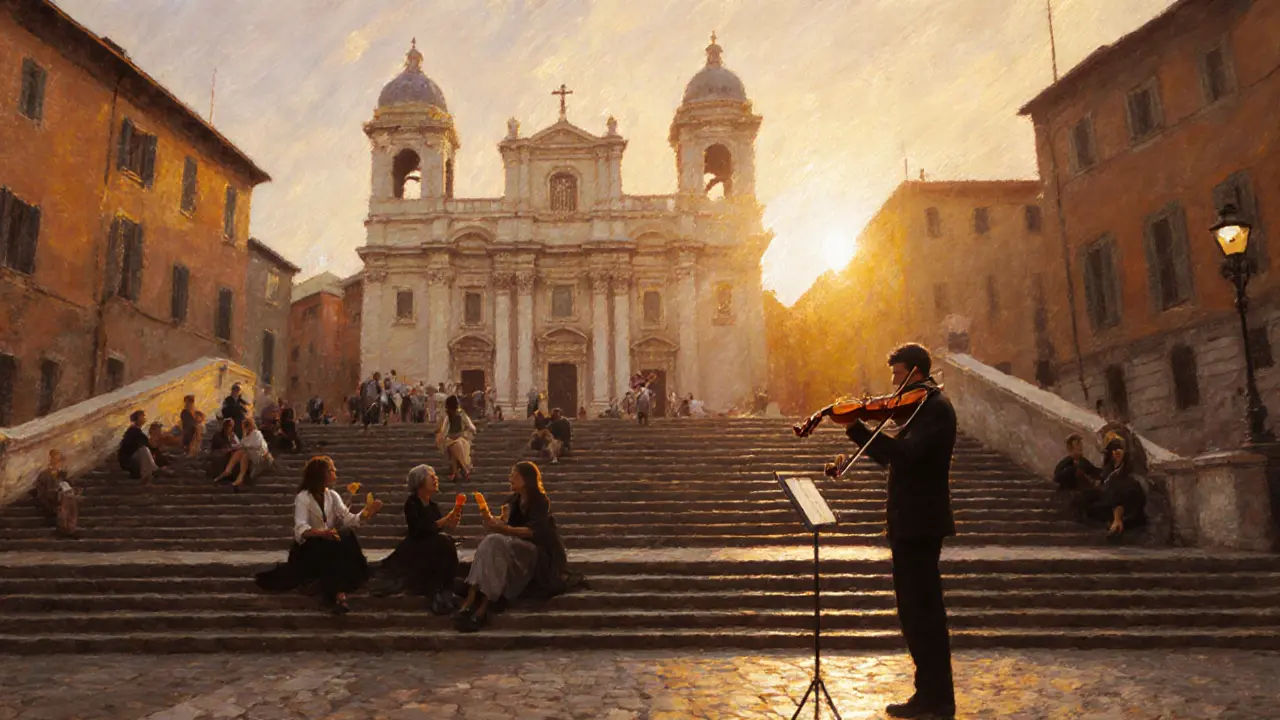
Wander the Trastevere Neighborhood
Trastevere is where Rome feels real. Narrow alleys, laundry hanging between buildings, tiny churches with frescoes you’ll miss if you’re not looking. This is the neighborhood where Roman families still live, where nonnas sell homemade gnocchi from their windows, and where the scent of garlic and rosemary drifts from open kitchen doors. Find Osteria da Fortunata-no menu, just what’s fresh that day. Ask for the carbonara. It’s made with guanciale, egg yolks, pecorino, and black pepper. No cream. No onions. Just Roman tradition. Eat at the counter. Watch the chef work. He’s probably been doing this since he was 16.
Discover the Hidden Gardens of Villa Borghese
Most visitors rush past Villa Borghese to hit the museums, but the gardens are where Rome breathes. Walk past fountains shaped like dolphins, past statues of Roman gods half-buried in ivy, and down paths lined with cypress trees that have stood since the 1600s. Rent a bike or just wander. Find the Temple of Asclepius, a small circular ruin tucked behind a grove of olive trees. No crowds. No signs. Just you, the birds, and the echo of ancient rituals. The gardens stretch over 80 hectares-big enough to get lost in, small enough to feel intimate. Come here when you need to forget you’re in a city of 2.8 million people.
See the Trevi Fountain at Night
Everyone tosses a coin into the Trevi Fountain. But most do it in broad daylight, surrounded by selfie sticks and hawkers selling fake designer bags. Go after 9 p.m. The crowds thin. The fountain lights up, turning the white marble into liquid gold. The water crashes against the statues of Neptune and Tritons with a sound like distant thunder. Toss your coin over your left shoulder with your right hand. That’s the rule. And yes, it still works. Studies from the city show that over €1.5 million is collected from the fountain each year-and every euro goes to charity. You’re not just making a wish. You’re feeding Rome’s poor.
Walk the Appian Way
The Appian Way, or Via Appia Antica, was the first major Roman road, built in 312 BCE to connect Rome to Brindisi. Today, it’s a quiet, tree-lined lane paved with original basalt stones. Ride a bike or walk it. You’ll pass ancient tombs, crumbling aqueducts, and olive groves that have grown here for centuries. Stop at the Catacombs of San Callisto, where early Christians buried their dead in underground tunnels. The walls are carved with simple crosses and names. Some of those names are still remembered by families today. This isn’t a tourist site. It’s a sacred corridor of memory.
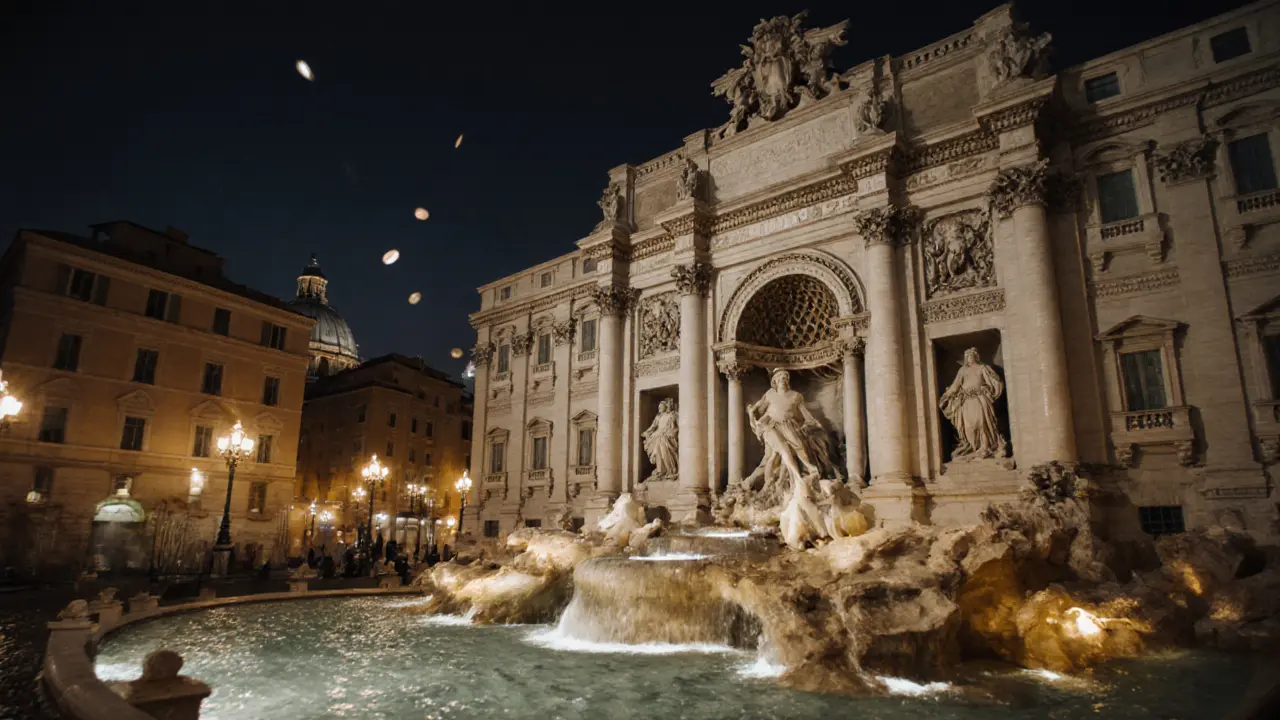
Visit the Vatican Museums Before the Crowds
The Vatican Museums hold over 70,000 works of art, including the Sistine Chapel. But if you go at 8:30 a.m., right when the doors open, you’ll have the place to yourself for 20 minutes. Walk through the Gallery of Maps-over 1,200 kilometers of Italian coastline painted on 40 walls-and feel the silence. Then step into the Sistine Chapel. Michelangelo painted the ceiling between 1508 and 1512, lying on his back. He was 33 when he finished. Look at the Creation of Adam. The gap between God’s finger and Adam’s isn’t just artistic-it’s theological. The moment before life. You’ll stand there, quiet, realizing you’re the first person to see it that day. That’s the magic.
Find the Mouth of Truth
The Bocca della Verità isn’t just a stone face with a hole for a mouth. It’s a 2,000-year-old Roman drain cover that became a legend. The story goes: if you lie while your hand is inside, it will bite off your fingers. Thousands test it every year. Most laugh. Some hesitate. A few pull their hands out fast. The truth? It’s not magic. It’s theater. But the line to try it? That’s real. And if you wait your turn, you’ll notice the woman next to you is crying. She’s not scared of the mouth. She’s thinking about her father, who told her this story when she was six. Now she’s here, with her own child, passing it on.
Drink Espresso at a Bar in Piazza Navona
Don’t sit at a table. Stand at the bar. Order a caffè espresso. No cappuccino after 11 a.m.-Italians don’t drink milk after breakfast. Watch the barista pull the shot. It takes 25 seconds. The crema should be thick, golden, and last longer than your sip. Pay €1.20. If you sit at a table, it’s €4. That’s not a markup-it’s a rule. This is how Rome works. You follow the rhythm, and it rewards you. Look around. The piazza is alive with street artists, children chasing pigeons, and an old man playing accordion. He’s been here since 1987. He doesn’t need a tourist brochure. He’s the attraction.
Watch the Sunset from Gianicolo Hill
Most tourists head to Castel Sant’Angelo for views. But the best sunset in Rome? It’s from Gianicolo Hill. Climb up the winding path past the Garibaldi statue. Find a bench facing west. The sun drops behind the dome of St. Peter’s Basilica, painting the Tiber River in shades of copper and violet. Below you, the city hums-cars, scooters, distant church bells. In the distance, you’ll see the Colosseum, the Pantheon, the Vatican-all lit up one by one. No one here is taking photos. Everyone is just breathing. This is Rome at its quietest, most honest moment.
What’s the best time of year to visit Rome for history and adventure?
Spring (April to June) and fall (September to October) are ideal. The weather is mild, crowds are thinner, and the light is perfect for walking ancient streets. Summer is hot and packed, while winter can be chilly and rainy-but quiet. If you want to experience the Colosseum without the tour buses, go in late October. The vines on the ruins are turning red, and the air smells like woodsmoke and old stone.
Can I explore Rome’s ancient sites without a guide?
Absolutely. Many sites, like the Roman Forum and the Appian Way, are open to the public with no guided tour required. Free audio apps like Rick Steves’ Rome or Google’s official Vatican app offer detailed commentary. But if you want to understand the symbolism behind a temple’s columns or the engineering of the Pantheon’s dome, a good guide adds depth. For solo travelers, pick a small-group tour-no more than 10 people-and ask if they’ll let you wander alone after the tour ends.
Is Rome safe for solo travelers exploring on foot?
Yes, Rome is generally safe for solo walkers, especially in tourist areas during the day. Avoid poorly lit alleys near Termini Station at night, and keep your wallet in a front pocket. Pickpockets target crowded spots like the Metro, Trevi Fountain, and tourist buses. But most locals are helpful. If you look lost, someone will stop and point you the right way-sometimes even walk you there. Rome rewards curiosity, not fear.
What should I wear to visit ancient sites in Rome?
Comfortable walking shoes are non-negotiable. Cobblestones are uneven, and many sites require climbing stairs or walking on uneven ground. Dress in layers-mornings are cool, afternoons get hot. Cover your shoulders and knees if you plan to enter churches or the Vatican. A light scarf works well. Bring a reusable water bottle. Tap water in Rome is safe and delicious-many fountains have spouts labeled "Acqua Potabile." Drink from them.
How much time do I need to see Rome’s top history spots?
You can hit the major sites-Colosseum, Roman Forum, Pantheon, Trevi Fountain, Vatican-in four days if you’re efficient. But to truly feel Rome, give yourself a week. Spend one day wandering Trastevere, another biking the Appian Way, another sitting in Villa Borghese with a book. Rome doesn’t rush. Neither should you. The best memories come from slow moments: a quiet corner of the Forum at dusk, a street musician playing near Piazza Navona, the taste of a perfect gelato after a long walk.
There’s no single way to experience Rome. You can rush through it like a checklist, or you can let it unfold slowly-like a book you read in the morning light, one page at a time. The Colosseum won’t disappear. The Trevi Fountain won’t run dry. But your chance to stand there, quiet and amazed, might. Take your time. Listen. Rome has been waiting for you for 2,700 years. It won’t mind if you’re a little late.

